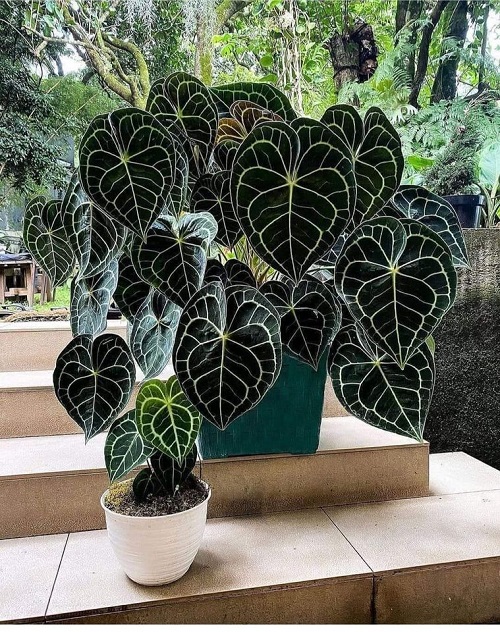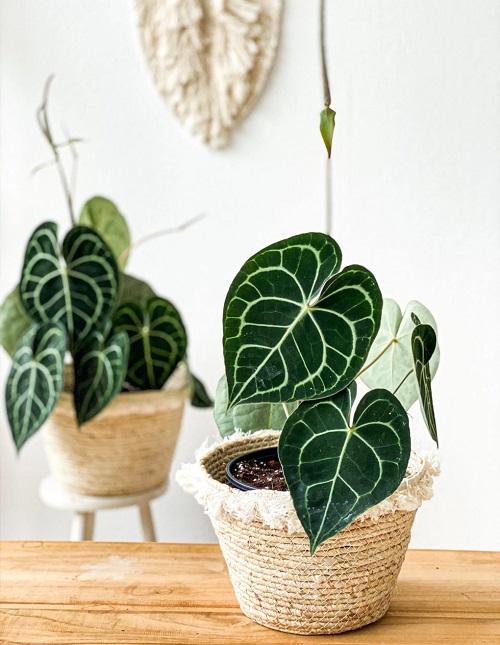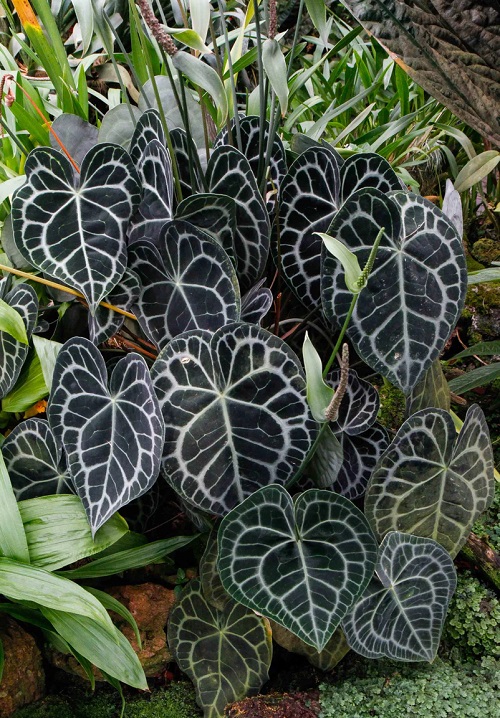Anthurium Clarinervium stands out with its remarkably veined foliage that can bring a striking appeal indoors!
Anthurium Clarinervium can be an easy to maintain indoor addition with a superb color combination of the foliage. Keep on reading to know how to grow it.
Read about Anthurium Pallidiflorum Care and Information here
Anthurium Clarinervium Information
The velvet cardboard anthurium, scientifically known as Anthurium Clarinervium, is a captivating species within the Anthurium genus, commonly referred to as the flamingo flower. It belongs to the arum family, Araceae.
In its natural habitat of Mexico, Anthurium Clarinervium thrives as an epiphyte, meaning it grows on trees or other plants without relying on the ground for sustenance. Remarkably, the velvet cardboard anthurium is not a parasite but rather ascends towards the treetops in search of optimal sunlight.
Its large, heart-shaped, dark green leaves possess eye-catching white patterns, which contribute to its popularity as a houseplant. While its flowers may not be particularly noteworthy, it is the striking appearance of its leaves that captivates plant enthusiasts.
Check out Anthurium Plant Care here
Propagating Anthurium Clarinervium

To propagate the Anthurium Clarinervium, try stem division. This involves carefully dividing the root ball into two or more parts, making sure that each portion possesses an adequate amount of roots and leaves to sustain its growth.
It is advisable to perform this process during the spring season when you are already planning to repot your anthurium.
When dividing the plant, exercise caution to minimize damage to the roots and ensure each divided section remains viable. Following the separation, transfer each part into its own individual pot. By undertaking propagation through stem division, you can expand your collection of Anthurium Clarinerviums!
Find How to Grow and Care for Anthurium Regale here
Requirements for Growing Anthurium Clarinervium
Location
Anthurium Clarinervium thrives in bright indirect light or filtered sunlight. It is important to shield these plants from excessive direct sunlight, although a moderate amount (2-3 hours of morning sunlight) is acceptable.
Soil
For optimal growth of your Anthurium Clarinervium, it is crucial to use well-draining soil that facilitates sufficient airflow to the roots.
Find out some Helpful Hacks to Improve Your Garden Soil for Free here
You can combine equal parts of pine bark and sphagnum moss or coco coir. This combination helps to maintain proper moisture levels while ensuring adequate aeration.
Water
Keep the soil consistently moist, avoiding waterlogging. As soon as the top layer of soil begins to dry out, it is time to water the plant again. Using room temperature water is best for watering Anthurium Clarinervium.
Here are the best ways to water plants
Temperature and Humidity
The ideal temperature range for Anthurium plants is between 60°F (15°C) and 90°F (32°C). They prefer temperatures on the warmer side, with daytime temperatures around 70°F (21°C) to 85°F (29°C) being optimal.
Anthuriums can tolerate temperatures slightly outside this range, but extreme heat or cold can stress the plant and hinder its growth.
Anthurium Clarinervium also appreciates high humidity levels. Aim to maintain humidity levels between 60% and 80% to mimic their natural rainforest habitat.
You can increase humidity by misting the leaves regularly or placing the plant on a tray filled with water and pebbles.
Here are 10 Ways To Increase Humidity For Houseplants That Work
Anthurium Clarinervium Care

Fertilizer
Although the velvet cardboard anthurium does not have high nutritional demands, providing regular fertilization during the growing season can encourage the development of lush foliage.
Here are DIY Dandelion Fertilizer Recipes
The recommended fertilizer for Anthurium Clarinervium s a standard liquid houseplant formula with a balanced ratio of 20-20-20. Dilute the fertilizer solution to half the recommended strength, and use it once in 4-6 weeks.
Pruning
Avoid unnecessary pruning of velvet cardboard anthurium leaves, as they are essential for photosynthesis and growth. Only trim or remove dead or severely damaged leaves by cutting or snapping the petioles at the main stem.
For minor blemishes like browned tips, use sterilized small scissors to trim the affected areas carefully.
Pests and Diseases
Prevent pests on Anthurium Clarinervium by periodically using neem oil or insecticidal soap. After applying, gently blot the leaves dry.
Rinse off spider mite webs and yellow bumps, drying the leaves carefully. Use yellow sticky traps for fungus gnats and treat larvae with hydrogen peroxide in water. Remove mealy bugs with a cotton ball soaked in rubbing alcohol.
Here are 50 Types of Common Pests in Your Garden & How to Get Rid of Them
To avoid Anthurium clarinervium diseases, maintain proper watering and keep leaves dry. If diseases occur, remove infected parts and replant them in fresh soil.
Anthurium Clarinervium – Toxicity
Anthurium clarinervium contains calcium oxalate crystals, which can cause irritation and discomfort if they come into contact with the skin, mouth, or digestive system. Symptoms of Anthurium toxicity may include mouth and throat irritation, drooling, difficulty swallowing, and in rare cases, nausea and vomiting.
If you have small children or pets that may be prone to nibbling on plants, it is advisable to keep Anthurium clarinervium out of their reach.



